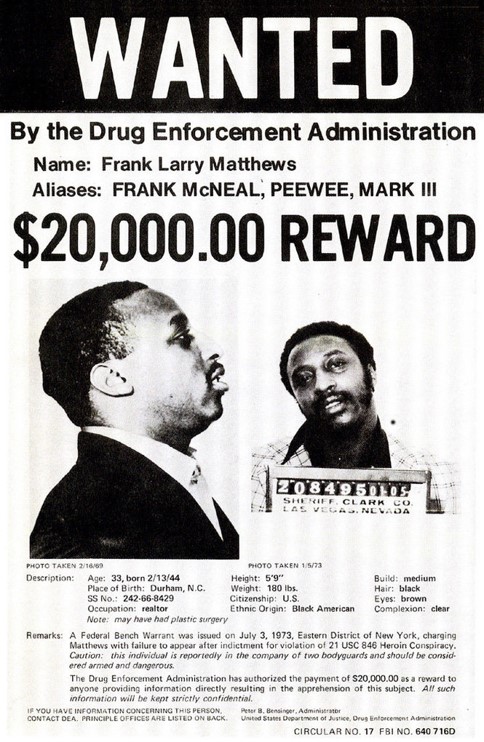Could Frank Matthews truly be the most elusive figure in American criminal history? A bold statement asserts that he was richer than Frank Lucas and wielded more power than the Mafia, making him the biggest drug dealer in America. Despite this notoriety, his story remains shrouded in mystery, leaving many questions unanswered about his fate and legacy.
Matthews' rise to prominence occurred during an era marked by flashy drug kingpins like Nicky Barnes and Frank Lucas. Yet, unlike these contemporaries who faced public trials and imprisonment, Matthews vanished into thin air after amassing a fortune estimated at $130 million. His disappearance has fueled speculation for decades, with some believing he fled to the Bahamas while others suggest he might still be alive under a new identity. The intrigue surrounding his life and career continues to captivate those interested in organized crime history.
| Personal Information | Details |
|---|---|
| Name | Frank Matthews |
| Date of Birth | January 1945 (approx.) |
| Place of Birth | New York City, USA |
| Career | Drug Trafficker |
| Net Worth | $130 million (estimated) |
| Notable Achievements | Largest cocaine distributor in America during the early 1970s |
| Status | Presumed deceased or living under assumed identity |
| Reference | The Mob Museum |
In January 1973, Matthews was reportedly spotted with his young girlfriend in New York City before disappearing without a trace. Law enforcement officials were baffled by his ability to evade capture despite extensive investigations. Some accounts claim that Matthews had established connections within law enforcement agencies, enabling him to receive advanced warnings about raids and arrests. These allegations added another layer of complexity to his already enigmatic persona.
The film Frank Matthews released in 2012 attempts to shed light on his life and crimes through a fictionalized narrative. Running for 1 hour and 23 minutes, it portrays Matthews as a man who operated above the law due to his immense wealth and influence. Although rated unrated, the movie captures the essence of his audacious lifestyle and the lengths he went to protect his empire.
Beyond his involvement in narcotics trafficking, Matthews also ventured into legitimate businesses such as real estate development. This duality made it challenging for authorities to build a solid case against him since much of his income appeared legally acquired. Additionally, his charitable contributions further complicated matters by portraying him as a community benefactor rather than a ruthless criminal.
Young Dolph's tribute to Matthews through the release of Paper Route Frank highlights the lasting impact of his legend on popular culture. The vinyl edition of the album includes special features like an augmented reality cover, reflecting modern technology's role in keeping historical figures relevant today. With over 110,000 likes on social media platforms, the project demonstrates widespread interest in exploring themes related to entrepreneurship and resilience inspired by Matthews' story.
Interestingly, another individual named Frank Matthews served as head coach for Wilkes University's softball team between 2000 and 2015. Prior to joining academia, he spent eleven years as athletic director and softball coach at Hanover Area High School. While unrelated to the infamous drug trafficker, this Frank Matthews contributed significantly to sports education throughout northeastern Pennsylvania.
Meanwhile, Frank P. Matthews Company specializes in providing expert advice regarding tree planting and maintenance services across the United Kingdom. Their comprehensive resources include instructional videos and written guides designed to assist individuals in achieving successful outcomes when cultivating trees on their properties. Such diversification underscores the versatility associated with the surname 'Matthews,' which spans various industries worldwide.
Returning to the criminal underworld, David H. Anthony III's research reveals insights into Matthews' operational strategies. Unlike traditional organized crime syndicates reliant upon hierarchical structures, Matthews adopted decentralized methods involving multiple independent operators working simultaneously yet separately. This approach minimized risks associated with betrayal and ensured continuity even if key members were apprehended.
Despite numerous efforts by local, state, and federal agencies, no definitive evidence exists confirming whether Matthews remains alive or perished shortly after going missing. Investigators have explored leads pointing towards potential relocation sites including Caribbean islands known for harboring fugitives from justice. However, none have yielded conclusive results thus far.
Ultimately, Frank Matthews' story serves as a reminder of how intricate networks can thrive beneath society's surface levels. Whether viewed as a mastermind entrepreneur or dangerous outlaw depends largely upon perspective; nonetheless, his contribution to shaping contemporary perceptions about illicit commerce endures indefinitely.



